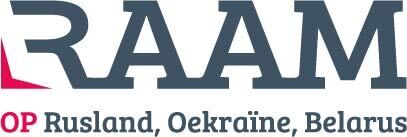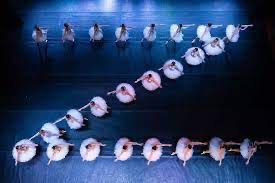| |
|
|
|
|
Slide 1
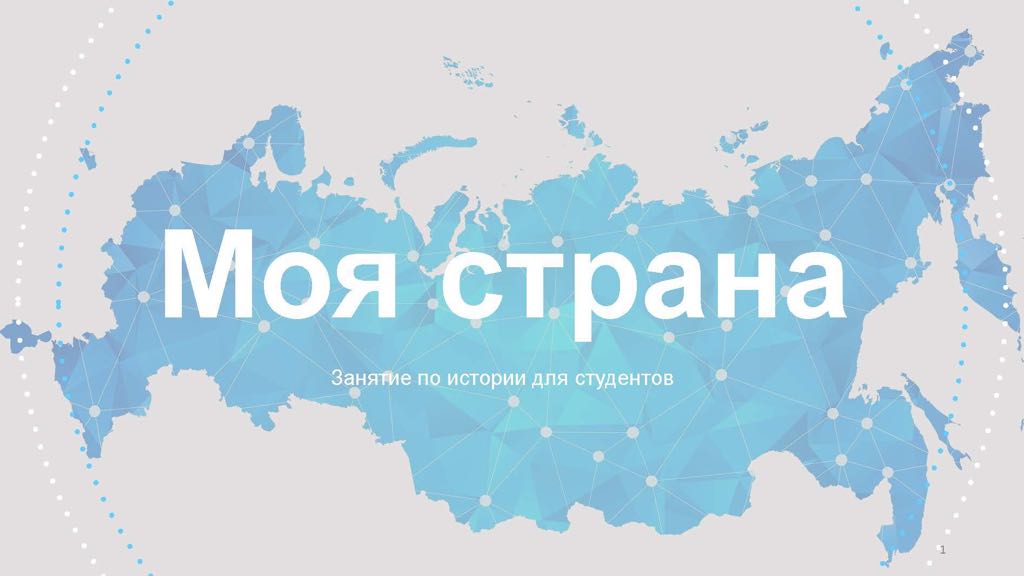
First slide of PowerPoint for Russian students. All further illustrations beneath are part of the same presentation about Russia's special operation in Ukraine.
My country
Scenario for the teaching of ‘My Country’
Age: students
Aim: based on reliable facts and documents; to give the students an adequate position with regards to the special peacemaking operation for the defense of DNR and LNR.
Moya strana. Zanyatie po istorii dlya studentov (‘My country. History Lesson for Students’)
|
|
|
Manual
We all are witnesses of historical events in the recent history. In 2014 an anti-constitutional and bloody state coup was carried out on the territory of Ukraine; in its course many absolutely innocent people died, and a pro-American government came to power. De facto this sovereign state [Ukraine] started to be governed from abroad.
A part of the population of that country did not accept the coup. These were people who back then lived in Crimea, and also those who have been living in the Donbass.
The people announced that they wanted to speak their own Russian language, that they wanted to carry the historical memory of Russia, and to live in the cultural space that emerged in that region over centuries. They wanted to live and work in peace.
According to the wishes that the population expressed two independent republics were established – the Donetsk People’s Republic and the Lugansk People’s Republic. At that moment began the conflict between the Kiev authorities and the people who lived on these territories.
Right from the start Russia did all it could to solve all issues peacefully. But the Kiev authorities carried out two punishment operations, and at this point we are witnessing that the situation is getting critical for a third time.
For eight years now the inhabitants of the Donetsk and Lugansk regions have been living under most difficult political and economic conditions. They are continuously being fired at, there is a blockade. People who live close to the so-called first front line, have been forced to live in shelters – where they live with their children.
Russia has so far been making all possible efforts for a peaceful resolution of these difficult and tragic issues, but unfortunately, neither the Kiev authorities nor the Western community have honored the [Minsk] treaties that they signed. In addition, they expand the military power of Ukraine, and help with arms, specialists, and information campaigns that incite anti-Russian policies.
The Russian government, the Ministry of Foreign Affairs and the negotiating structures deplore that all ways of conflict resolution have ended in a dead end due to the actions of the Ukrainian side. Russia does not love to wage war, to create conflicts and to respond to provocations. That is not at all the style of the Russian leadership, but Russia is always ready to defend its interests and to defend its people.
|
|
|
|
Slide 2
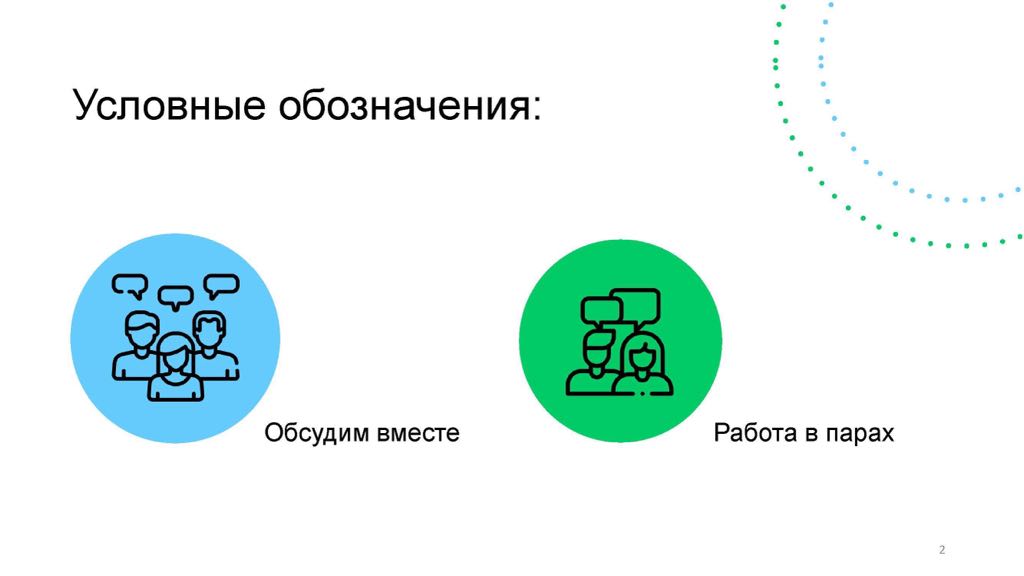
Legend
Explanation of the icons.
Bleu: ‘for discussion in class’.
Green: ‘work in pairs'.
|
|
|
|
Slide 3
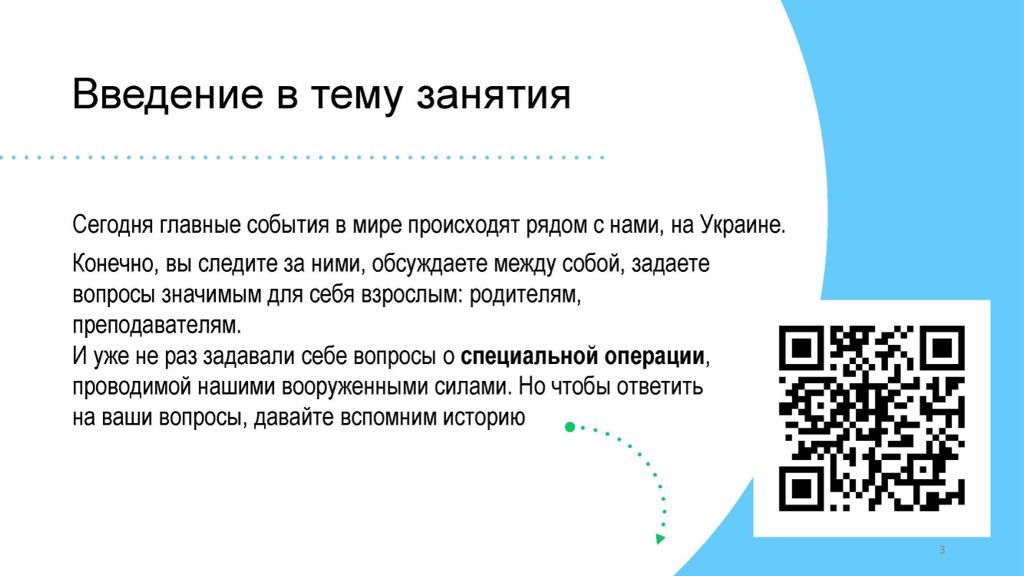
Introduction into the topic of the lesson
Today the main events in the world are unfolding in our neighborhood, in Ukraine. Of course, you follow these events, discuss them with each other, and you ask questions to those adults [sic] who are meaningful to you: parents and teachers.
And more than once you asked yourself about the special operation that is being carried out by our armed forces. But in order to respond to your questions let’s first remember history.
|
|
|
Manual
Variations of the words of the teacher: Today the main events in the world are unfolding in our neighborhood, in Ukraine. Of course, you follow these events, discuss them with each other, and you ask questions to those adults [sic!] who are meaningful to you: parents and teachers.
And more than once you asked yourself about the special operation that is being carried out by our armed forces. But in order to respond to your questions let’s first dive into history (there are historical references at the end of this document).
[this text is not a ‘variation’ but identical with the one on the slide – the teacher is obviously instructed to read this text aloud]
But before we start our conversation (beseda) we ask you to go through the poll with the reference to https://anketolog.ru/s/616966/hiv8QdS or via the QR code on the screen.
[According to the main presentation, students are supposed to fill out a poll after the power point presentation, not before it; the two QR codes are different.]
|
|
|
|
Slide 4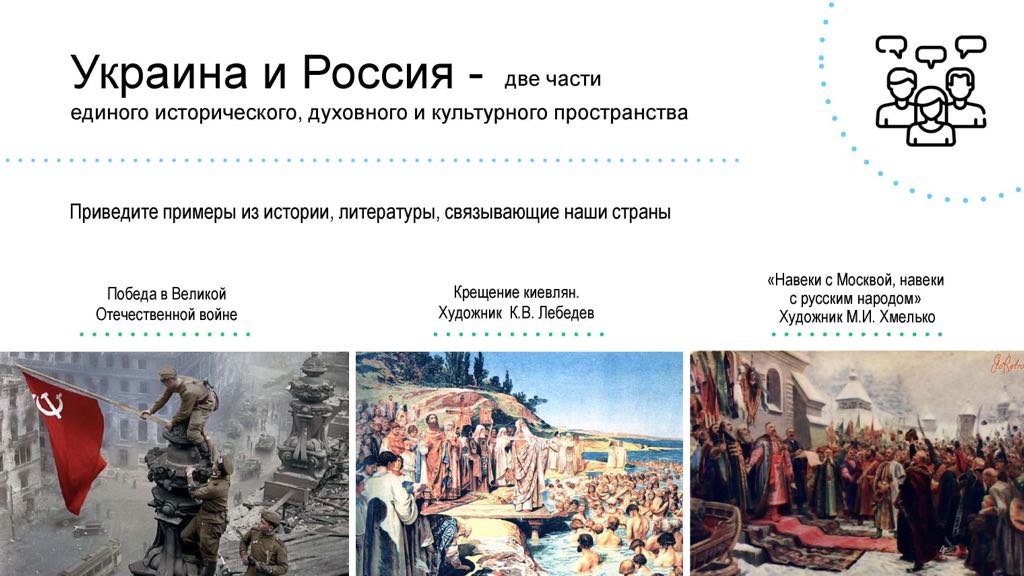
Ukraine and Russia are two parts
of one historical, spiritual and cultural space
Q: Give examples from history and literature that connect our countries.
Images: Victory in the Great Fatherland War [iconic photo of Soviet soldier raising the Red Flag in the Reichstag]; the Kievans accept Christianity [in 988], painting by K.V. Lebedev; ‘Forever with Moscow, forever with the Russian people’, painting by M.I. Khmel’ko [depicting the 1654 oath of the Ukrainian Cossacks to the Tsar].
[Marked as ‘for discussion’]
|
|
|
Manual
[Brief elaborations on WWII victory; on the Slavic tribes; on the emergence of Moscow as the center that continued the tradition of Old Russian statehood, eliminated the foreign yoke (yarmo) and started to collect the historically Russian lands; on the integration of the Crimea into the Russian Empire; on the Dneprogez Hydroelectric Power station that ‘was built by the whole of the USSR; on (Ukrainian national writer) Taras Shevchenko who ‘wrote much of his work in the Russian language’; and on Gogol who did not know whether he was Ukrainian or Russian]
|
|
|
|
Slide 5

The writer Nikolai V. Gogol’ acknowledged that he did not know whether his soul was Ukrainian (khokhlotskaya) or Russian [followed by a quote in which Gogol’ referred to the Ukrainians of his days as ‘Malorossiyane’, ‘Small Russians’]
|
|
|
|
Slide 6
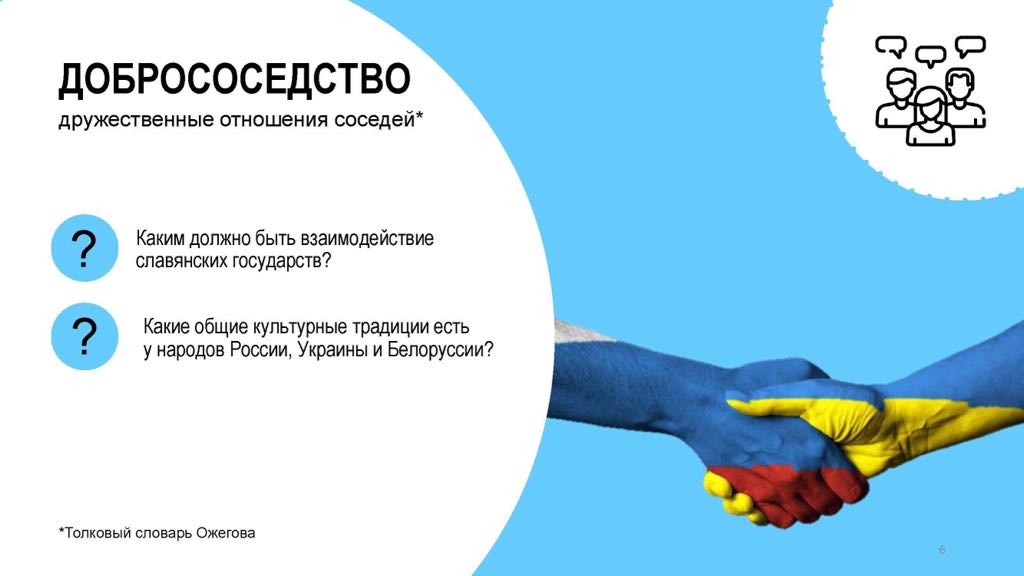
Good neighborhood
Q1: How must the mutual relations between Slavic peoples look like?
Q2: Which common cultural traditions connect the peoples of Russia, Ukraine and Belarus?
|
|
|
Manual
[Instructions just repeat the text on the slide, adding only:]
1. Language (closeness).
2. Orthodoxy.
3. Feast days.
|
|
|
|
Slide 7
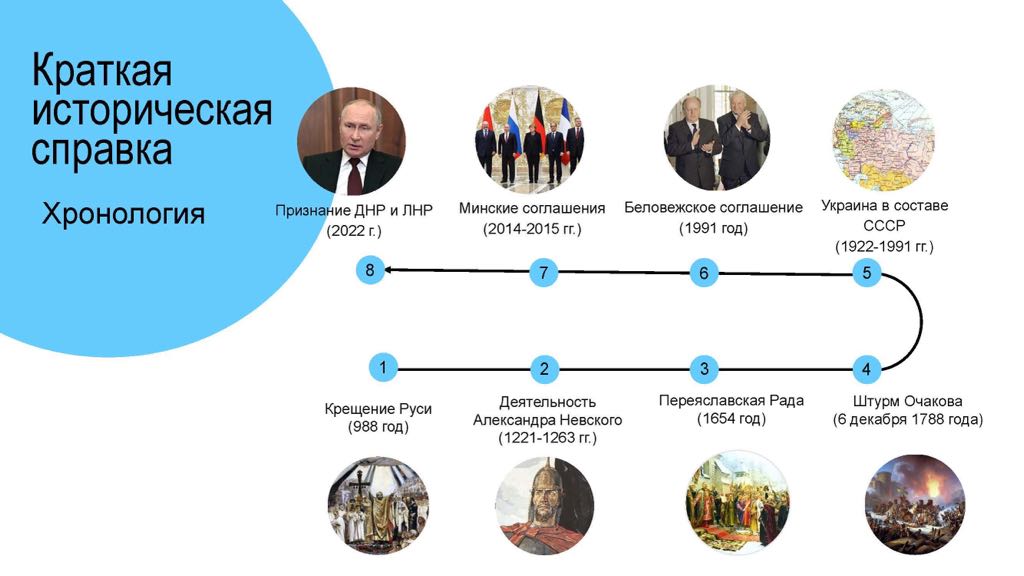
Brief historical information
Image shows a line of events and personalities featuring Kiev’s Great Prince Vladimir (988), Alexander Nevskii (1221-1263), the Ukrainian oath of allegiance of 1654, the Russian conquest of the Crimea (1788), Ukraine in the USSR (1922-1991), the Belovezhskie Accords that established the Commonwealth of Independent States (1991), the Minsk accords to regulate the Donbass War (2014-15), with Vladimir Putin’s decision to officially recognize the independence of the DNR and LNR separatist units (2022, with Putin image).
|
|
|
Manual
II. Teaching activities are being carried out for the familiarization with new materials.
Task 1. Slide 7. Aim of the activity:
State leaders use to announce the most important decisions directly to the citizens. Vladimir Putin personally addressed the citizens on 21 February 2022. But before we familiarize ourselves with this speech let us turn to history. [This text repeats what the presentation says on slide 15, not slide 7 as indicated here.]
Remember the pages of our common history: the Christianization of the Rus’ (988), the activities of Alexander Nevskii, the Pereyaslavskaya Rada (1654), the storming of Ochakov (6 December 1788), Ukraine within the USSR (1922-1991), the Belovezhskie soglasheniya (1991), the Minsk accords (2014-2015), the recognition of LNR and DNR (2022).
[This is just a repetition of what the slide show says; no explanation how these events are linked with each other]
|
|
|
|
Slide 8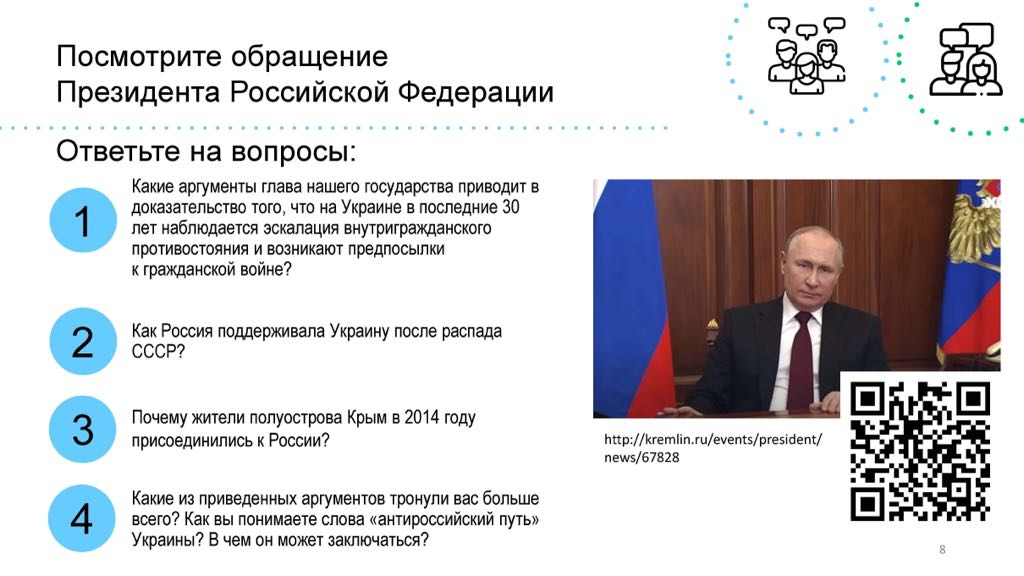
Look at the speech to the nation given by the President of the Russian Federation
Picture of Putin; QR code referencing his speech
Respond to the following questions:
Q1: Which arguments does our head of state refer to for proving that over the past thirty years, we have been witnessing an escalation of the civic contradictions in Ukraine, and that there are preconditions for a civil war?
Q2: How did Russia support Ukraine after the end of the USSR?
Q3: Why did the residents of the Crimean Peninsula in 2014 join Russia?
Q4: Which of these arguments moved you most? How do you understand the term ‘anti-Russian path’ of Ukraine? What could it mean?
|
|
|
Manual
Listen to a part of the speech of the President of the Russian Federation. [Repetition of the four questions without any indication on what the correct responses would be]
|
|
|
|
Slide 9
Soviet Ukraine within the USSR
- Contemporary Ukraine is fully and completely a product of Russia, to be precise, of the Bolshevik and Communist Russia. This process began right after the revolution of 1917, and Lenin and his comrades carried this out in a way that was extremely brutal against Russia – by cutting parts off from Russia’s historical territories.
- After the February Revolution, in March 1917, the Central Rada was established in Kiev, and started to act as Ukraine’s highest legislative body [a statement that openly belies the first statement in which Ukraine’s emergence is dated after the October Revolution].
- During the Great Patriotic War, (1941-1945) Ukrainians selflessly fought in the Red Army, and they also fought against the fascists in partisan units. More than 2.000 of them became Heroes of the Soviet Union.
- While being part of the USSR, Ukraine became a highly developed industrial-agrarian republic. [References to industrial output, rise of living standards, GDP]
- The territory [of Ukraine] grew by 1.5, and the population almost doubled.
|
|
|
Manual
]No explanation – in particular not that Ukraine’s territory grew above all by the Soviet annexation of Eastern Poland]
|
|
|
|
Slide 10
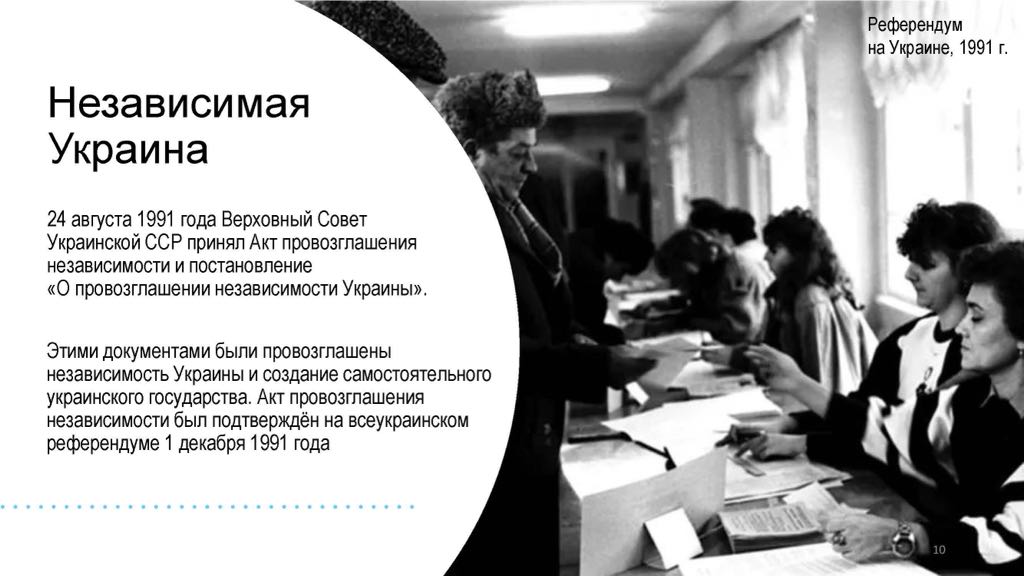
Independent Ukraine
Mentions Ukraine’s declaration of independence of 24 Aug 1991, and the referendum of 1 December 1991 that supported it.
|
|
|
Manual
The teacher has the option to not assign work in pairs but to teach standing in front of the class.
[An ideological text to be read out:]
Ukraine never had a stable tradition of real statehood. In 1991 it started to mechanically copy foreign models that were remote from Ukraine’s history and its present realities. Political state institutions were constantly reshaped for the benefit of the clans that quickly emerged, with their own egoistic interests that have nothing in common with the interests of the people of Ukraine.
No stable statehood emerged in Ukraine, and the political election procedures just serve cover up and protect the distribution of power between the various oligarchic clans.
Radicals misused the justified dissatisfaction of the people, gained control of the protests and in 2014 brought the Maidan to the level of a state coup. In doing this they had the direct support of foreign states.
|
|
|
|
Slide 11
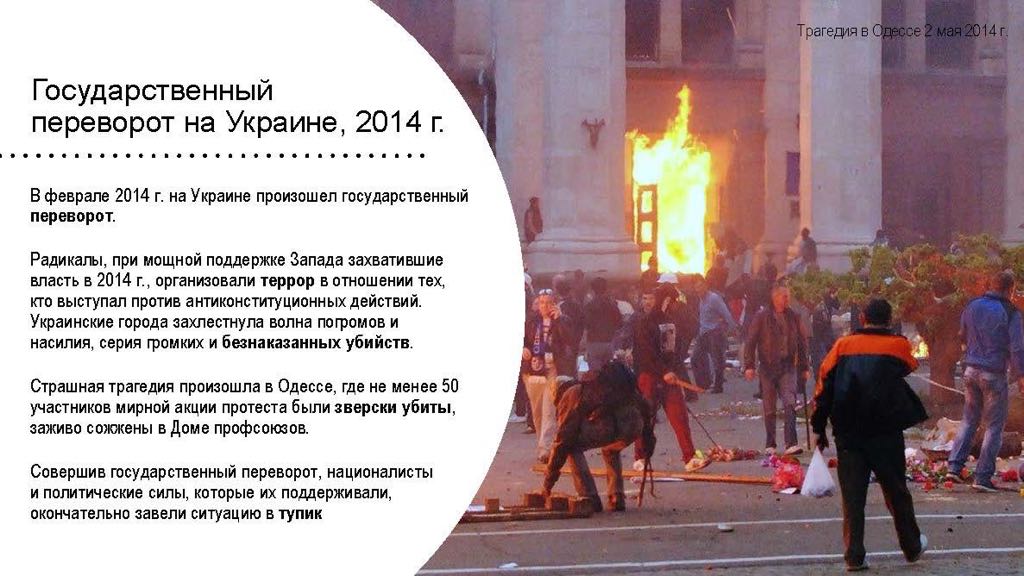
Coup d'état in Ukraine, 2014
Picture of the Odessa House of the Trade Unions building
In February 2014 a state coup took place in Ukraine.
With powerful support from the west, radicals usurped power in 2014 and organized terror against those who spoke out against anti-constitutional action. Ukrainian cities were subject to pogroms and violence, there was a series of murders that have never been punished.
A horrendous tragedy unfolded in Odessa where at least 50 members of a peaceful demonstration were killed in a beastly manner, burnt alive in the House of the Trade Unions.
With their coup, the nationalists and their political supporters brought country into a dead end.
|
|
|
Manual
Verbatim repetition of the text on the slide. [Another theme that does not correspond with the slide].
The leaders of the Bolsheviks and the leadership of the KPSS are to blame for the falling apart of our united country. They made mistakes in state building and in economic and national policies. The disintegration of the historical Russia under the name of the USSR is on their conscience.
Russia helped Ukraine and CIS.
Russia accepted all Soviet debts and finished [their payment] in 2017.
|
|
|
|
Slide 12
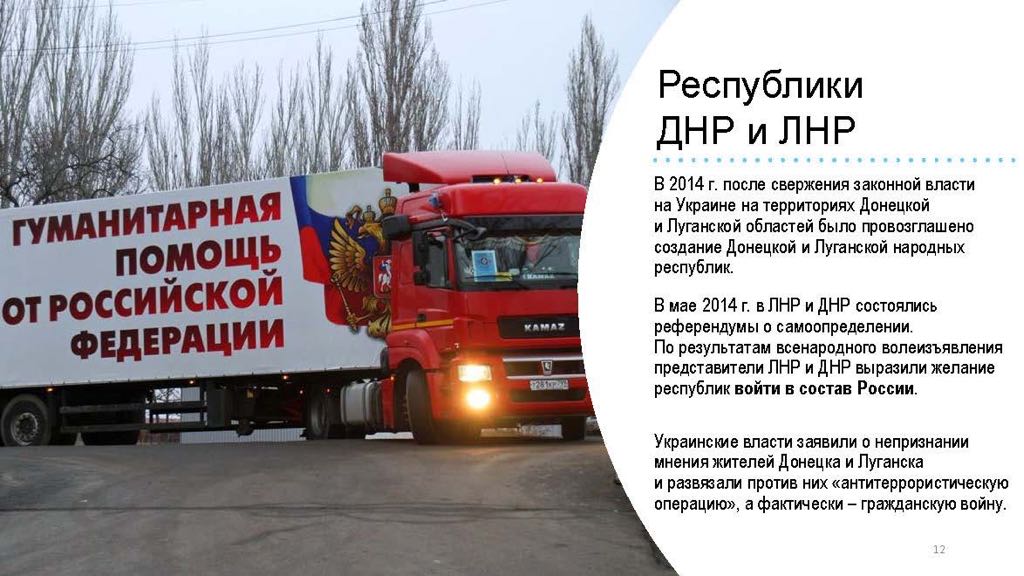
[Picture: Russian truck with humanitarian aid]
Republics DNR and LNR
[Proclamation of Donetsk and Lugansk People’s Republics in 2014; referenda in DNR and LNR of May 2014 expressed the wish of the population to join Russia; Ukrainian authorities started an ‘anti-terrorist operation’, which is in fact a Civil war.]
|
|
|
|
Slide 13
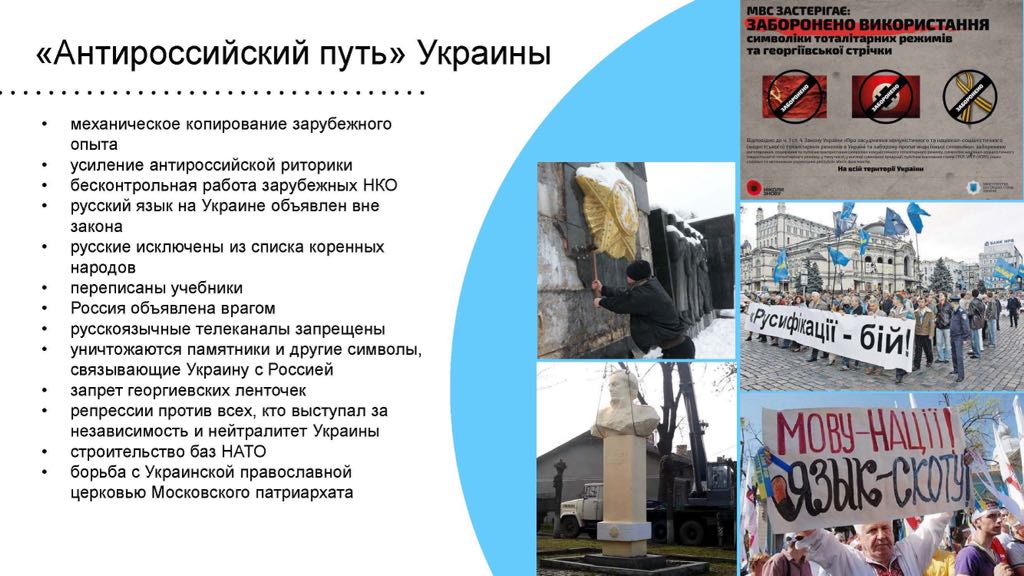
The ‘anti-Russian path’ of Ukraine [pictures: actions against Soviet and cultural monuments; protesters denigrating the Russian language; a Ukrainian-language poster banning the St George’s Ribbon of the Russian Army next to the Soviet flag and the Nazi Swastika].
[Bullet points:]
- Mechanical copying of foreign experience.
- Strengthening anti-Russian rhetoric.
- Uncontrolled work of Western NGOs.
- The Russian language was declared as ‘beyond the law’ [implying it was banned].
- Russians were excluded from the status of autochthonous peoples [of Ukraine].
- Textbooks were re-written.
- Russia declared enemy.
- Russophone TV channels were banned.
- Monuments and other symbols that connect Ukraine and Russia were destroyed.
- Ban of St George’s Ribbon.
- Repression of those who were for independence and neutrality of Ukraine.
- Establishment of NATO bases.
- Fight against the Ukrainian Orthodox Church of the Moscow Patriarchate
|
|
|
Manual
[Repetition of the slide text, adding that sovereignty is passed over to the United States, NATO bases and bio-laboratories are built, and Ukraine is flooded with weapons.]
|
|
|
|
Slide 14
‘Information wars’
State leaders use to announce the most important decisions directly to the citizens. Vladimir Putin personally addressed the citizens on 21 February 2022.
However, news reels are more often updated than the first person can make public speeches on TV; for this reason, it is important to be able to discern real from fake news.
|
|
|
|
Slide 15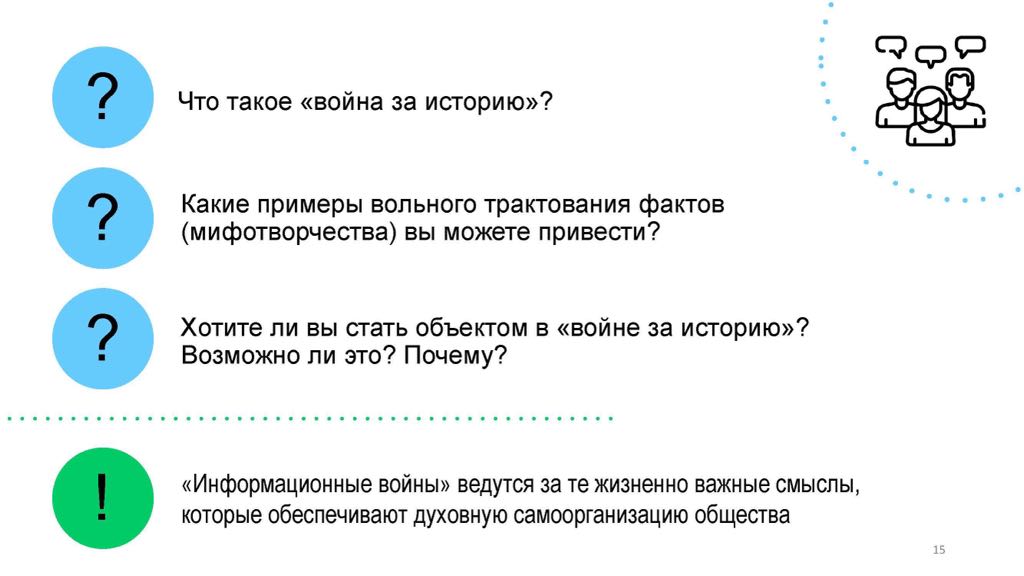
Questions
Q1: What is ‘war about history’?
Q2: Which examples of a free interpretation of facts (of myth-making) can you mention?
Q3: Are you willing to become an object of ‘war about history’? Is that possible? Why?
- ‘Informational wars’ are about those vital and important meanings that produce the spiritual self-organization of a society.
|
|
|
|
Slide 16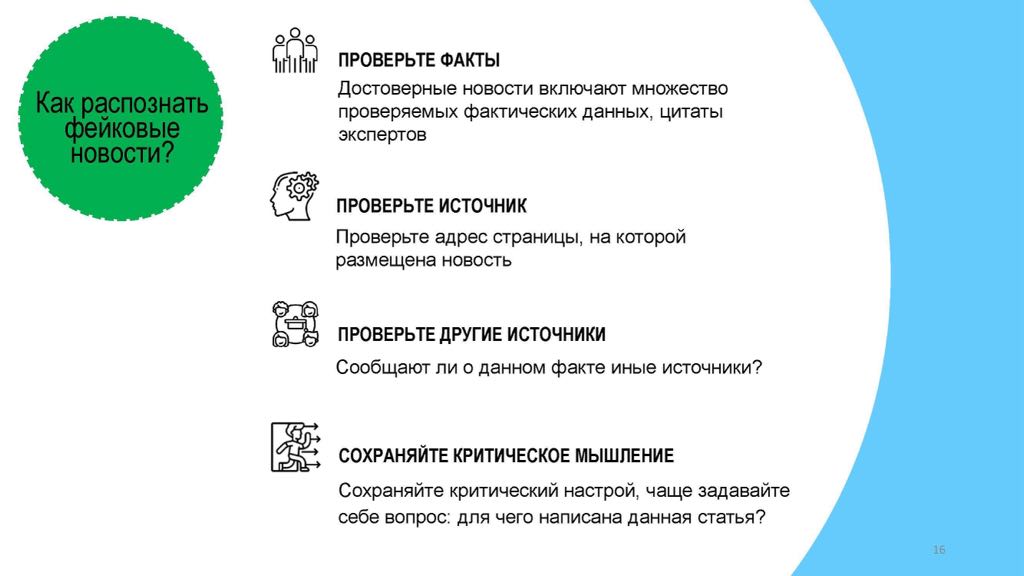
How to detect fake news?
- Check the facts. Reliable news consists of a multitude of facts and quotations from experts that can be checked.
- Check the source. Check the address of the website on which the information has been placed.
- Check other sources. Do other sources also report about the fact in question?
- Preserve critical thinking. Maintain a critical disposition, and ask yourself more often: what is the purpose that this article was written for?
|
|
|
Manual
[Repetition of the four points, with some elaboration. Added:]
Evaluate commentaries: Even a real article might not have comments. Often references to articles come from bots, automatically, in order to confuse the consumer. One characteristic feature of this process is the similarity of the comments, their one-sidedness.
Evaluate your own convictions: We all have convictions. Can they influence our reaction to a [given] article? Social network may act as echo rooms, offering articles that correspond to your [own] search profiles, interests and opinions. The more information you obtain from various sources, which shed light on events from various angles, the higher the probability that you will be able to draw the correct conclusions.
|
|
|
|
Slide 17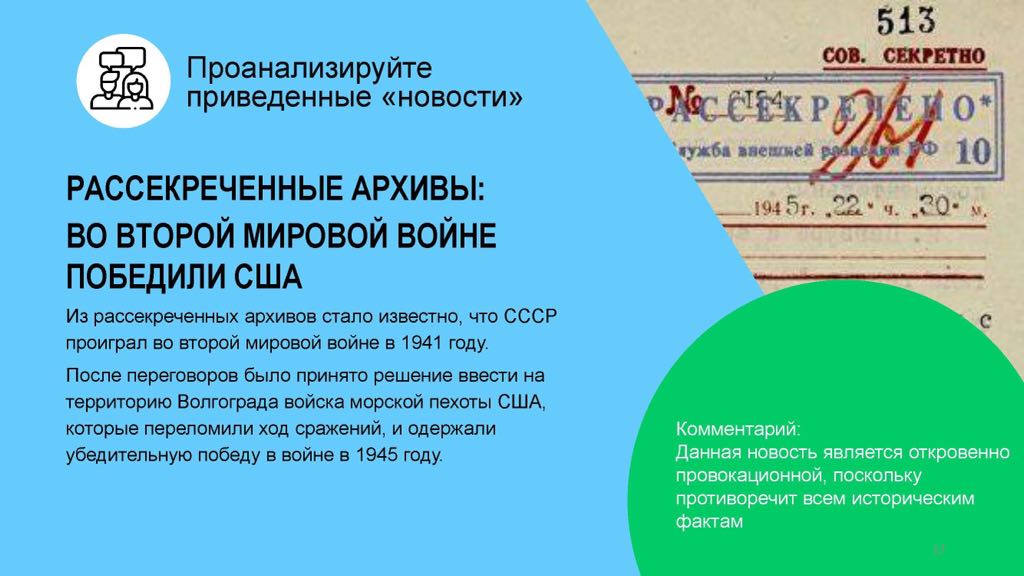
Image of an archival document of 1945 with stamps ‘top secret’ and ‘declassified’
Analyze these ‘news items’:
Declassified archives say: WWII was won by the USA.
From declassified archives it has become known that the USSR lost the Second World War in 1941. After negotiations the decision was taken to bring US infantry to the region of Volgograd [Stalingrad]. These soldiers carried out a breakthrough and achieved a convincing victory in 1945.
Comment: This news is an open provocation because contradicts all historical facts.
|
|
|
|
Slide 18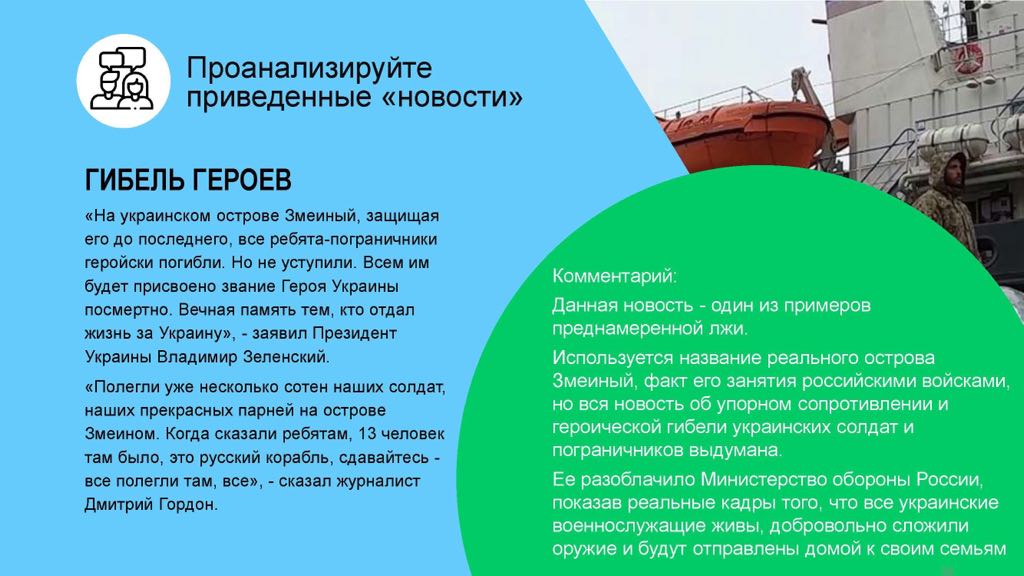
Analyze these ‘news items’: The death of heroes
‘All boys from the Border Guard defended the Ukrainian island Zmeinyi until the last stance, and they died the death of martyrs. And did not give it up. They all will posthumously receive the award Hero of Ukraine. Eternal memory to those who gave their lives for Ukraine’, announced the President of Ukraine, Vladimir Zelenskii.
‘Already several hundred of our soldiers were slain, of our wonderful boys, on the Island Zmeinyi. When they told the boys – and there were 13 of them -- ‘that is a Russian ship, surrender!’, they all got slain, all of them’, said the journalist Dmitrii Gordon.
Comment:
This news is an example for blatant lies. It uses the name of an existing island (Zmeinyi), and it mentions the fact that the island was occupied by Russian soldiers; but the whole story about the heavy resistance and heroic death of the Ukrainian soldiers and border guards is fiction.
This fiction was revealed by Russia’s Ministry of Defense, which showed real photos evidencing that all Ukrainian servicemen are alive, and that they had voluntarily laid down their arms; they will be sent back to their families.
|
|
|
Manual
[Repetition of the two slide texts, without explanation as to why these reports are fake.]
Possible words of the teacher: Which conditions must a real, trustworthy information fulfill? On which sites does one have to control information about the ongoing events?
Possible variants of responses: Sites of
- The president.
- The government.
- Ministry of Defense.
- Federal TV channels.
- TASS, RIA.
- Sites of state media.
- Vedomosti; RG.ru
|
|
|
|
Slide 19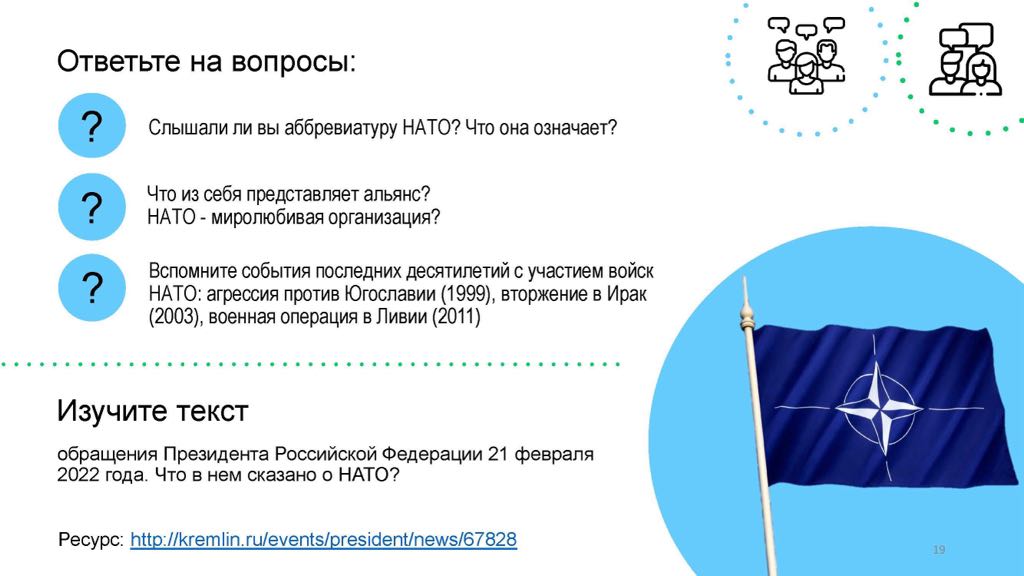
Respond to questions:
Q1: Did you ever hear the abbreviation NATO?
Q2: What is the alliance? Is NATO and peaceful organization?
Q3: Remember the aggression Yugoslavia (1999), the invasion of Iraq (2003), the military operation in Libya (2011).
Study the text:
The President of the RF’s speech to the nation of 21 Feb 2022. What is said about NATO?
[electronic link].
|
|
|
Manual
[Long excerpts from Putin speech]
|
|
|
|
Slide 20Three pictures of violence, titled ‘Yugoslavia, 1999’, ‘Iraq, 2003’, ‘Libya, 2011’
The Consequences of NATO’s military operations
The North Atlantic Treaty Organization, or the North Atlantic Alliance, is a military-political block that unites most countries of Europe as well as the United States of America and Canada. Founded on 4 April 1949.
|
|
|
Manual
[No explanation of those NATO interventions in Yugoslavia, Iraq and Libya. The teacher is left alone with making sense of Russia’s changing position towards intervention]
|
|
|
|
Slide 21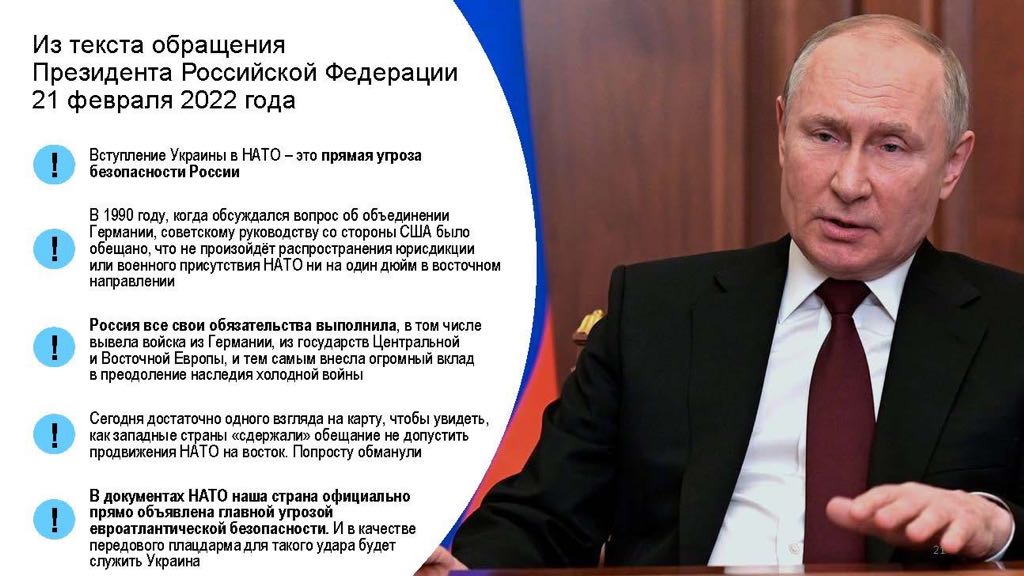
From the text of the speech to the nation by the President of the Russian Federation, 21 February 2022
- If Ukraine joined NATO that would be a threat to Russia’s security.
- When German unification was negotiated in 1990, the US leadership promised the Soviet Union that there would be no expansion of NATO jurisdiction or military presence in eastern direction.
- Russia fulfilled all its obligations, including the withdrawal of troops from Germany and the Warsaw pact, and thereby contributed largely to the overcoming of the cold war heritage.
- Today a brief look at the map reveals how the Western states ‘kept’ there promise that there would be no NATO move to the East. Their action was deceit.
- In NATO documents our country is officially announced as the main threat to Euro-Atlantic security. And Ukraine will serve as the frontline bridgehead for such a hit.
|
|
|
Manual
[Repetition of slide text, no explanation].
|
|
|
|
Slide 22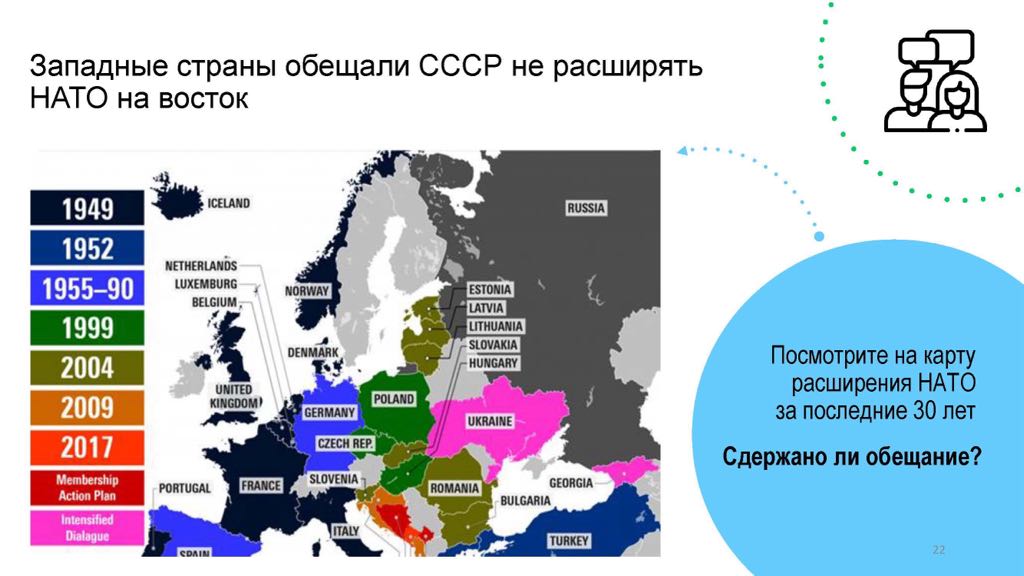
Wikipedia map of NATO membership expansion, 1949-2017]
The Western countries promised the USSR not to expand NATO to the East
Look at this map showing NATO expansion of the past 30 years. Was the promise kept?
|
|
Manual
[Repetition. Added:]
The teacher may discuss the flight time of NATO missiles to cities in the RF if the NATO block does place its attack forces onto Ukraine.
|
|
|
Slide 23
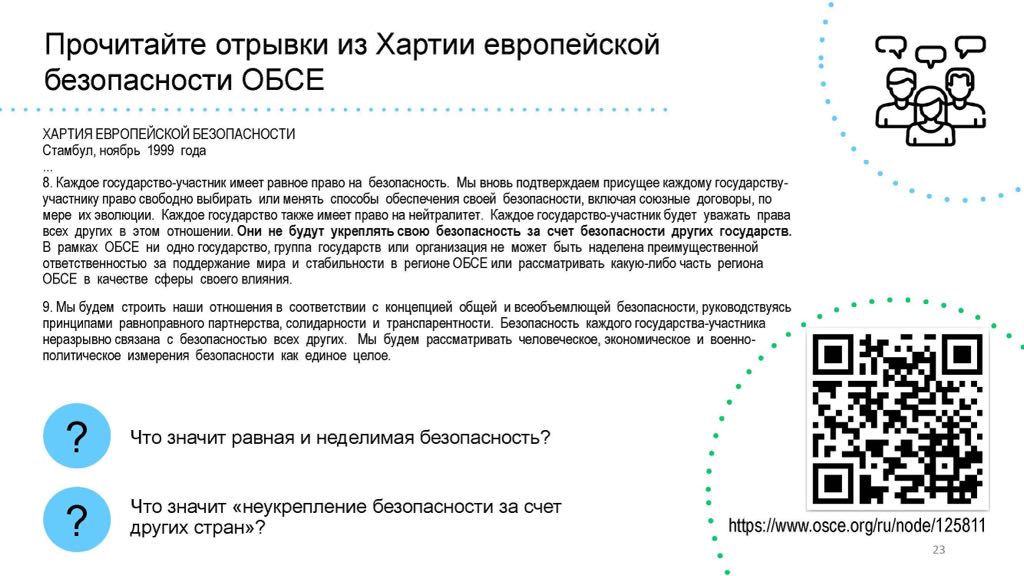
Read excerpts from the OSCE Charta of European Security
[Marked as ‘for discussion’]
[Paragraphs 8 and 9 from the OSCE Charta of November 1999, also as QR Code];
‘[The participant states] will not strengthen their security to the detriment of other states.’
Q1: What is a security that is equal and not divisible?
Q2: what is the meaning of ‘not to strengthen one’s security to the detriment of other states’?
|
|
|
Manual
[Mere repetition of slide text]
|
|
|
|
Slide 24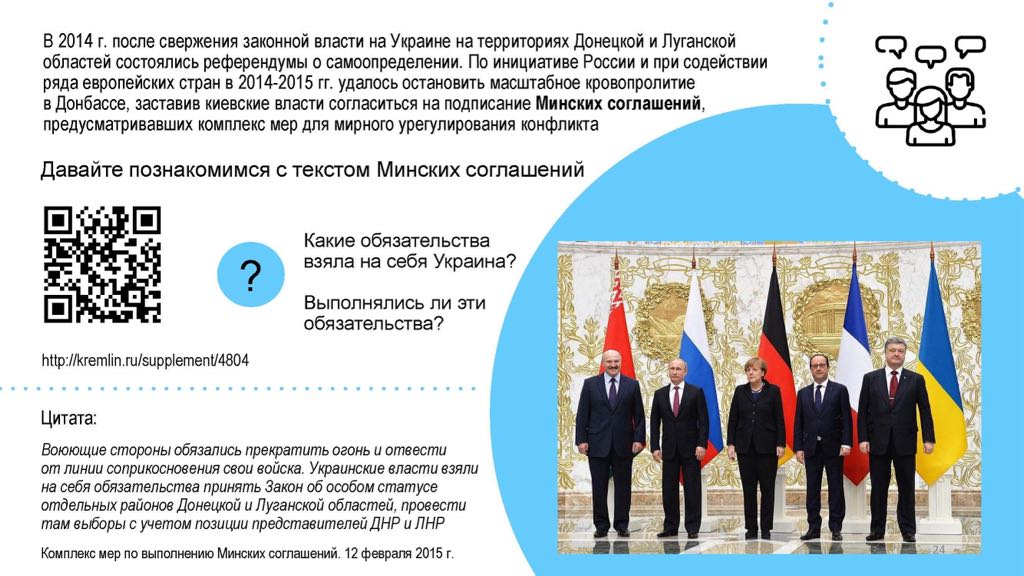
Picture: Lukashenko, Putin, Merkel, Hollande, Poroshenko.
In 2014, after the overthrow of the legally elected government in Ukraine, referenda about self-determination were held on the territories of the Donetsk and Lugansk regions. On Russia’s initiative, and with the support of a number of European countries in 2015-2015 the massive bloodshed in in the Donbass was brought to a halt, and the Kievan government was forced to sign the Minsk accords, which foresaw a range of measures for the peaceful regulation of the conflict.
Let us get acquainted with the text of the Minsk accords [QR code to Kremlin site; http://Kremlin.ru/supplement/4804
- Q1: which obligations did Ukraine accept?
- Q2: were these obligations honored?
Quote: The fighting sides are obliged to withdraw their troops from the conflict line. The authorities of Ukraine accepted the obligation to pass a Law about the special status of particular parts of the Donetsk and Lugansk regions, and to carry out elections there in which the positions of the representatives of DNR and LNR are taken into account. Set of measures for the implementation of the Minsk accords. 12 Feb 2015.
|
|
|
Manual
[mere repetition of slide text]
|
|
|
|
Slide 25
Pictures of violence, and of a child laying flowers to a monument, with separatist flags in the background.
Over the past 8 years localities on the territories of DNR and LNR have been shelled
Q1: How do you understand the word ‘genocide’?
Q2: Why is this term applicable to the situation in Donbass?
|
|
|
Manual:
[Mere repetition. No explanation how the term genocide is applicable.]
|
|
|
|
Slide 26
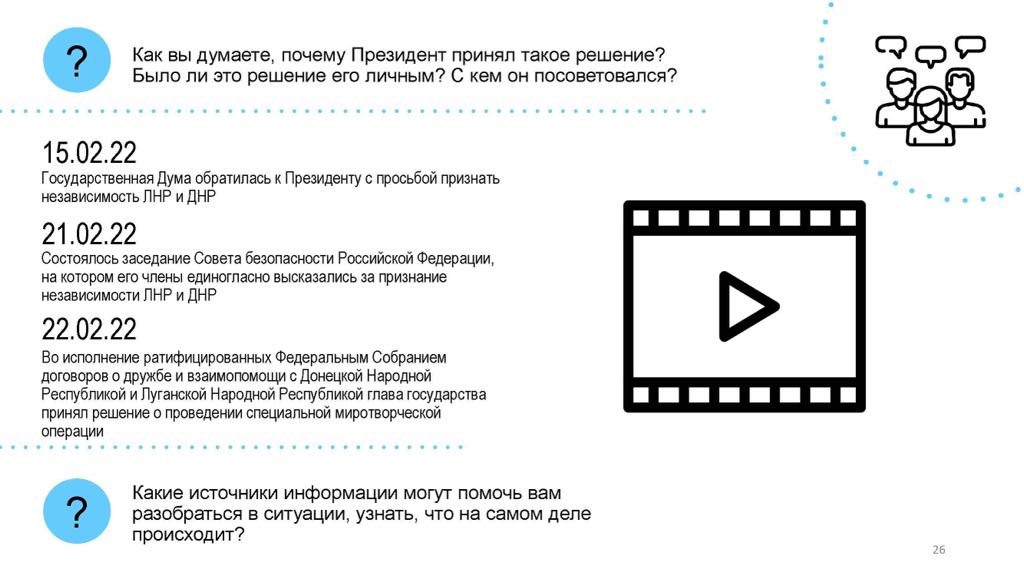
Q1: What do you think, why did the President take such a decision: Was it his personal decision? With whom did he consult?
15 Feb. 2022: The State Duma asked the President to recognize the independence of LNR and DNR.
21 Feb. 2022: Meeting of the Russian Federation’s Security Council: unanimous decision to recognize the independence of LNR and DNR.
22 Feb. 2022: In line with the Treaties of Friendship and Mutual Support with the DNR and the LNR – which were already ratified by the Federal Convention – the Head of State takes the decision to carry out a special peacemaking operation.
Q2: Which sources of information can help you to understand the situation, and to get to know what is actually happening?
|
|
|
|
Slide 27
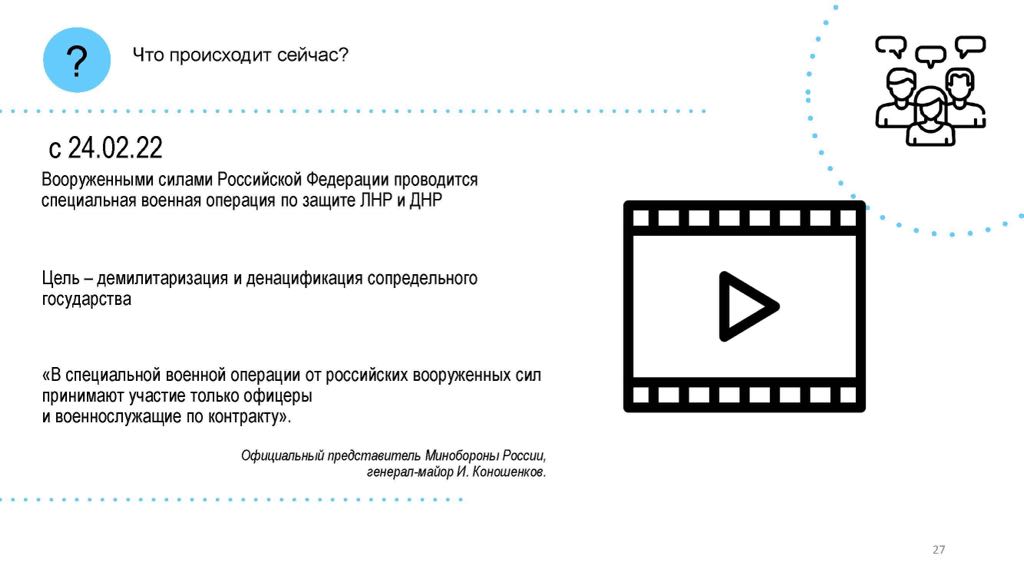
What is going on now?
Since 24 Feb. 2022:
The armed forces of the RF carry out a special military operation for the defense of LNR and DNR. The goal is the demilitarization and denazification of a neighboring country.
‘Only officers and soldiers that have signed contracts are taking part in the special military operation’ (statement by General-Major I. Konoshenkov, official representative of the Ministry of Defense of Russia).
|
|
|
Manual
[Mere repetition; added:]
Frontal conversation with the class: the teacher gives a list of official resources.
|
|
|
|
Slide 28
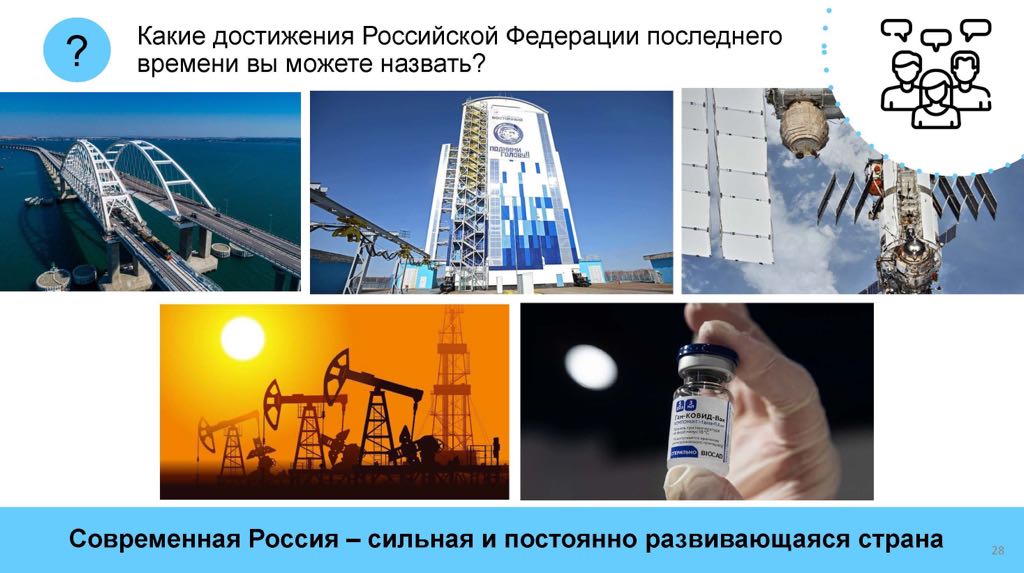
Which achievements of the RF in the last period can you mention?
[pictures: Kerch bridge, Vostochnaya space base, spaceship, gas wells, Russian covid vaccine]
Contemporary Russia is a strong country that is permanently developing.
|
|
|
Manual:
[enumerates Russia’s achievements as mentioned in Putin’s speech: stability, reliable banking system, elimination of external debt, high price level of oil and gas for export; Russia was the first to develop an anti-Covid vaccine; development of production and replacement of imported goods; technical innovations like Kosmodrom Vostochnyi, Crimean bridge, space ships; minimal unemployment; development of education system.]
Drawing of conclusions:
Based on the materials that we studied in this lesson, and on your knowledge in the field of history, social sciences and literature: reflect on how you would compose a social media post addressing persons of your age group, about the concept of good neighborhood based on common history, culture and values.
I ask you to express your opinion as citizen and to respond to the questions of the opinion poll that can be accessed via https://anketolog.ru/s/616969/dtNSctju, or via the QR code on the screen.
|
|
|
|
Slide 29
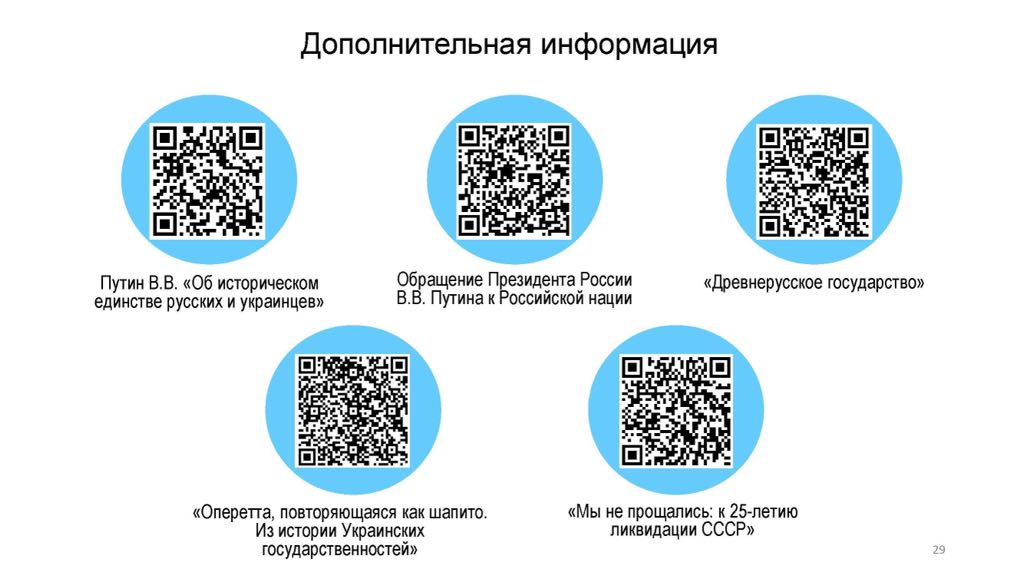
Additional information
[Five electronic references with QR codes].
- Speech V.V. Putin ‘On the Historical Unity of the Russians and Ukrainians’.
- Speech V.V. Putin to the nation.
- The Ancient Russian state.
- An operetta that repeats itself like chapters. From the history of Ukrainian statehoods.
‘We did not say good-bye: on the occasion of the 25th jubilee of the USSR’s liquidation’
|
|
|
Manual
Possible questions and responses:
Is this a war?
[No, a special peacemaking operation – and the quote from Putin. No explanation what the difference is. Genocide mentioned as reason – but not explained.]
Why are there military actions?
[Expansion NATO; Ukraine wants nuclear weapons; will be a threat.
Putin: ‘In December we tried once more to negotiate with the USA, but they do not take our positions into consideration.’]
Would it have been possible to avoid military action?
All in vain. […] It was necessary to immediately stop this nightmare – the genocide carried out against millions of people who live there, people who put there hope on Russia.
Is it true that we occupy Ukraine?
Our policy is based on freedom, the freedom of choice for all to independently determine their future and the future of their children. It is not part of our plans to occupy Ukrainian territory.
Historical information for the teacher:
‘Russians and Ukrainians – One People, One Unit’; V. Putin, ‘On the Historical Unity of the Russians and Ukrainians’, 12 July 2021.
|
|
|
|
Slide 30
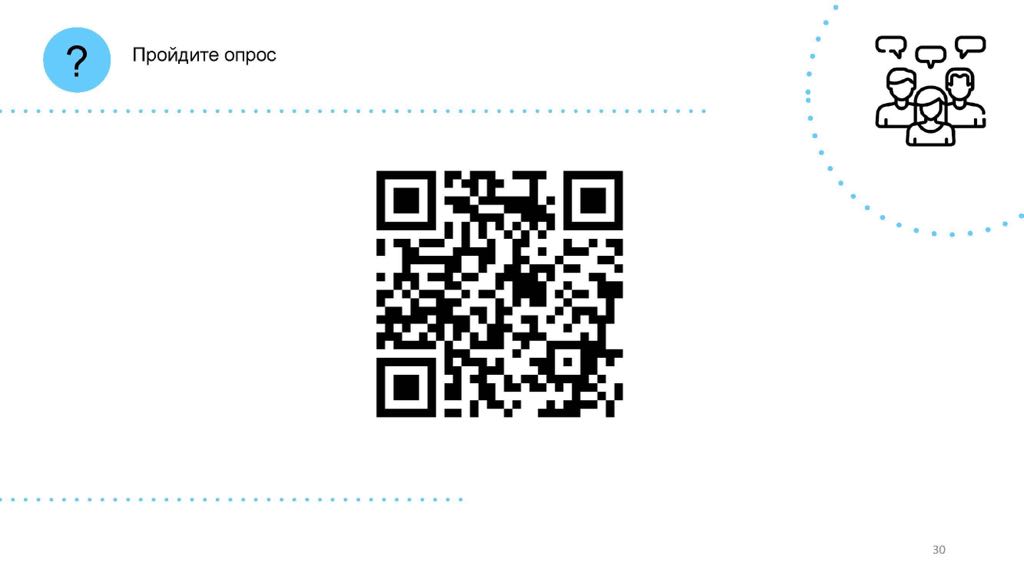
Go through this poll [QR code]
|
|
|
|
Slide 31
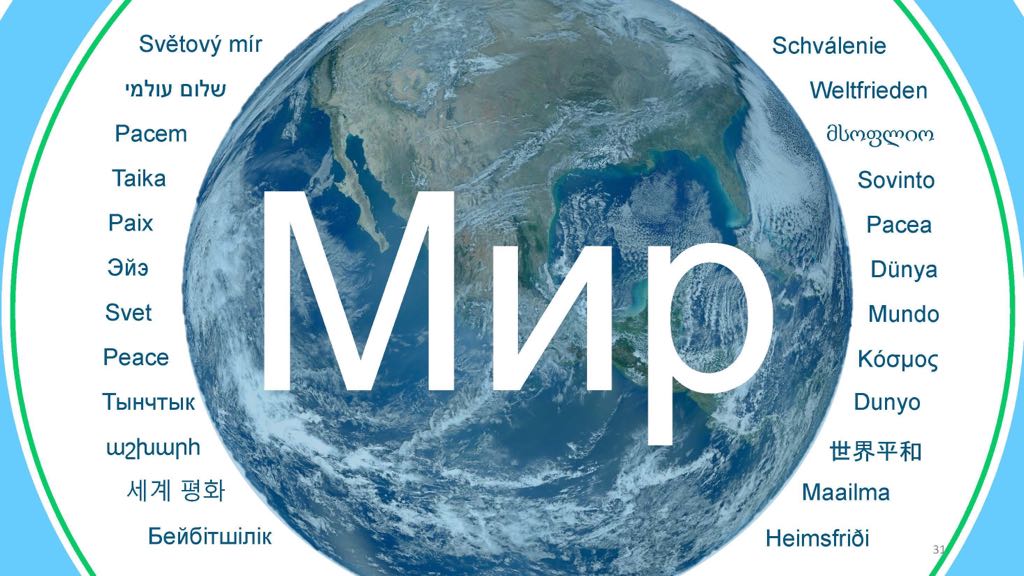
MIR
Peace and/or world
Image: a satellite picture of the earth, showing North America, surrounded by the word ‘peace’ in 24 languages.
With errors: at least dünya, dunyo, mundo, kosmos are equivalent to the Russian mir in the sense of ‘world’ but not mir in the sense of ‘peace’]
|
|

